Taíno
The Taíno were an indigenous people of the Caribbean.[2] At the time of European contact in the late fifteenth century, they were the principal inhabitants of most of Cuba, Hispaniola (the Dominican Republic and Haiti), Jamaica, Puerto Rico, The Bahamas and the northern Lesser Antilles. The Taíno were the first New World peoples to be encountered by Christopher Columbus during his 1492 voyage. They spoke the Taíno language, an Arawakan language.[3]
.jpg) | |
| Regions with significant populations | |
|---|---|
| Cuba, Dominican Republic, Haiti, Jamaica, Puerto Rico, Bahamas | |
| Languages | |
| English, Spanish, Creole Languages Taíno (historically) | |
| Religion | |
| Native American religion | |
| Related ethnic groups | |
| Lokono, Island Carib, Garifuna, Igneri, Guanahatabey, Yamaye |
Groups of people currently identify as Taíno, most notably among the Puerto Ricans, Cubans, Jamaicans, and Dominicans, both on the islands and on United States mainland.[4] Some scholars, such as Jalil Sued Badillo, an ethnohistorian at the University of Puerto Rico, assert that although the official Spanish histories speak of the disappearance of the Taínos as an ethnic identification, many survivors left descendants – usually by intermarrying with other ethnic groups. Recent research revealed a high percentage of mixed or tri-racial ancestry in Puerto Rico and the Dominican Republic.
Taíno activists have created two unique writing scripts. The scripts are used to write Spanish, not a retained language from pre-Columbian ancestors.[5]
In February 2018, a DNA study from an ancient tooth determined that the Taínos have living descendants in Puerto Rico, indicating that most Puerto Ricans have a degree of Taíno ancestry.[6]
Frank Moya Pons, a Dominican historian, documented that Spanish colonists intermarried with Taíno women. Over time, some of their mixed descendants intermarried with Africans, creating a tri-racial Creole culture. Census records from the year 1514 reveal that 40% of Spanish men on the island of Hispaniola had Taíno wives.[7] Ethnohistorian Lynne Guitar writes that the Taíno were declared extinct in Spanish documents as early as the sixteenth century; however, individual Taínos continued to appear in wills and legal records for several decades after the arrival of the Spaniards.[8]
Evidence suggests that some Taíno men and African women inter-married and lived in relatively isolated Maroon communities in the interior of the islands, where they developed into a hybrid population of peasants with little or no interference from the Spanish authorities.[9] In the Spanish Colony of Jamaica, known as the Colony of Santiago, Taino men and women fled to the Bastidas Mountains, later called the Blue Mountains by the English, where they intermingled with escaped African slaves, and were the ancestors of the Jamaican Maroons of the east, including those communities led by Juan de Bolas and Juan de Serras. The Maroons of Moore Town claim descent from the Taino and escaped African slaves.[10] Scholars also note that contemporary rural Dominicans retain elements of Taíno culture: linguistic features, agricultural practices, food ways, medicine, fishing practices, technology, architecture, oral history, and religious views. Often these cultural traits are looked down upon by urbanites as backward, however.[8] Sixteen "autosomal" studies of peoples in the Spanish-speaking Caribbean and its diaspora (mostly Puerto Ricans) have shown that between 10–20% of their DNA is indigenous. Some individuals have slightly higher scores and others have lower scores or no indigenous DNA at all.[11] A recent study of a population in eastern Puerto Rico where the majority of persons tested claimed Taíno ancestry and pedigree showed that they had 61% mtDNA (distant maternal ancestry) and 0% y-chromosome DNA (distant paternal ancestry) demonstrating as expected that this is a hybrid creole population.[12]
The ancestors of the Taíno originated in South America, and the Taíno culture as documented developed in the Caribbean. Taíno groups were in conflict with the Island Caribs of the southern Lesser Antilles. At the time of contact, the Taíno were divided into several groups. Western Taíno groups included the Lucayans of the Bahamas, the Ciboney of central Cuba, and the inhabitants of Jamaica. The Classic Taíno lived in Hispaniola and Puerto Rico, while the Eastern Taíno lived in the northern islands of the Lesser Antilles.
At the time of Columbus's arrival in 1492, there were five Taíno chiefdoms in Hispaniola, each led by a principal Cacique (chief), to whom tribute was paid. The Taíno name for Hispaniola was Ayiti ("land of high mountains"), which is the source of the name Haiti. Cuba was divided into 29 chiefdoms, many of which have given their name to modern cities, including Havana, Batabanó, Camagüey, Baracoa, and Bayamo.[13] Taíno communities ranged from small settlements to larger centers of up to 3,000 people. They may have numbered 2 million at the time of contact,[3] and almost 3 million at the end of the 15th century.[14] Columbus was surprised by the civility of the Taíno people. Columbus stated, "They will give all that they do possess for anything that is given to them, exchanging things even for bits of broken crockery," he noted upon meeting them in the Bahamas in 1492. "They were very well built, with very handsome bodies and very good faces....They do not carry arms or know them....They should be good servants."[14]
The Spanish conquered various Taíno chiefdoms during the late fifteenth and early sixteenth century. According to The Black Legend and some contemporary scholars such as Andrés Reséndez, warfare and harsh enslavement by the colonists decimated the population.[15][16] Men were forced to work on colonial plantations and gold mines, as a result, there was no Taíno left to cultivate their own crops and feed their population.[14] Conversely, most scholars believe that European diseases caused the majority of deaths. A smallpox epidemic in Hispaniola in 1518–1519 killed almost 90% of the surviving Taíno.[17][18] The remaining Taíno were intermarried with Europeans and Africans, and were incorporated into the Spanish colonies. The Taíno were considered extinct at the end of the century. However, since about 1840, there have been attempts to create a quasi-indigenous Taíno identity in rural areas of Cuba, the Dominican Republic, and Puerto Rico. This trend accelerated among Puerto Rican communities in the mainland United States in the 1960s.[19] At the 2010 U.S. census, 1,098 people in Puerto Rico identified themselves as "Puerto Rican Indian", 1,410 identified as "Spanish American Indian", and 9,399 identified as "Taíno". In total, 35,856 Puerto Ricans considered themselves Native American.[20]
Terminology
A direct translation of the word "Taíno" signified "men of the good".[21] Additionally, the name was used by the indigenous people of Hispaniola to indicate that they were "relatives".[22] The Taíno people, or Taíno culture, has been classified by some authorities as belonging to the Arawak, as their language was considered to belong to the Arawak language family, the languages of which were present throughout the Caribbean, and much of Central and South America. The early ethnohistorian Daniel Garrison Brinton called the Taíno people the "Island Arawak".[23] Nevertheless, contemporary scholars have recognized that the Taíno had developed a distinct language and culture.
Taíno and Arawak appellations have been used with numerous and contradictory meanings by writers, travelers, historians, linguists, and anthropologists. Often they were used interchangeably; "Taíno" has been applied to the Greater Antillean nation only, or including the Bahamian nations, or adding the Leeward Islands nations, or all those excluding the Puerto Rican and Leeward nations. Similarly, "Island Taíno" has been used to refer to those living in the Windward Islands only, to the northern Caribbean inhabitants only, as well as to the population of the entire Caribbean.
Modern historians, linguists and anthropologists now hold that the term Taíno should refer to all the Taíno/Arawak nations, except for the Caribs, who are not seen to belong to the same people. Linguists continue to debate whether the Carib language is an Arawakan dialect or creole language, or perhaps an individual language, with an Arawakan pidgin used for communication purposes.
Rouse classifies as Taíno all inhabitants of the Greater Antilles (except the western tip of Cuba), the Bahamian archipelago, and the northern Lesser Antilles. He subdivides the Taíno into three main groups: Classic Taíno, mostly from Haiti, Puerto Rico, and the Dominican Republic; Western Taíno, or sub-Taíno, for population from Jamaica, Cuba (except for the western tip), and the Bahamian archipelago; and Eastern Taíno for those from the Virgin Islands to Montserrat.[24]
Origins
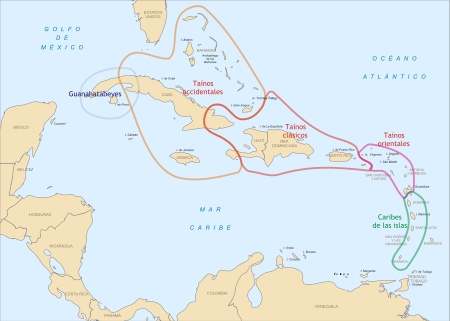
Two schools of thought have emerged regarding the origin of the indigenous people of the Caribbean.
- One group of scholars contends that the ancestors of the Taíno came from the center of the Amazon Basin, and are related to the Yanomama. This is indicated by linguistic, cultural and ceramic evidence. They migrated to the Orinoco valley on the north coast. From there they reached the Caribbean by way of what is now Guyana and Venezuela into Trinidad, proceeding along the Lesser Antilles to Cuba and the Bahamian archipelago. Evidence that supports this theory includes the tracing of the ancestral cultures of these people to the Orinoco Valley and their languages to the Amazon Basin.[25][26][27]
- The alternate theory, known as the circum-Caribbean theory, contends that the ancestors of the Taíno diffused from the Colombian Andes. Julian H. Steward, who originated this concept, suggests a migration from the Andes to the Caribbean and a parallel migration into Central America and into the Guianas, Venezuela, and the Amazon Basin of South America.[25]
Taíno culture as documented is believed to have developed in the Caribbean. The Taíno creation story says that they emerged from caves in a sacred mountain on present-day Hispaniola.[28] In Puerto Rico, 21st century studies have shown a high proportion of people having Amerindian MtDNA. Of the two major haplotypes found, one does not exist in the Taíno ancestral group, so other Native American people are also part of this genetic ancestry.[26][29]
Culture
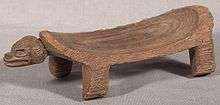
Taíno society was divided into two classes: naborias (commoners) and nitaínos (nobles). These were governed by male chiefs known as caciques, who inherited their position through their mother's noble line. The nitaínos functioned as sub-caciques in villages, overseeing naborias work. Caciques were advised by priests/healers known as bohiques. Caciques enjoyed the privilege of wearing golden pendants called guanín, living in square bohíos, instead of the round ones of ordinary villagers, and sitting on wooden stools to be above the guests they received.[30] Bohiques were extolled for their healing powers and ability to speak with deities. They were consulted and granted the Taíno permission to engage in important tasks.
The Taíno had a matrilineal system of kinship, descent, and inheritance. When a male heir was not present, the inheritance or succession would go to the oldest male child of the sister of the deceased. The Taíno had avunculocal post-marital residence, meaning a newly married couple lived in the household of the maternal uncle. He was more important in the lives of his niece's children than their biological father; the uncle introduced the boys to men's societies. Some Taíno practiced polygamy. Men, and sometimes women, might have two or three spouses. A few caciques had as many as 30 wives.
The Taíno women were highly skilled in agriculture. The people depended on it, but the men also fished and hunted. They made fishing nets and ropes from cotton and palm. Their dugout canoes (kanoa) were made in various sizes, which could hold from 2 to 150 people. An average-sized canoe would hold about 15–20 people. They used bows and arrows for hunting, and developed the use of poisons on their arrowheads.
Taíno women commonly wore their hair with bangs in front and longer in back, and they occasionally wore gold jewelry, paint, and/or shells. Taíno men and unmarried women were usually naked. After marriage, women wore a small cotton apron, called a nagua.[31] The Taíno lived in settlements called yucayeques, which varied in size depending on the location. Those in Puerto Rico and Hispaniola were the largest, and those in the Bahamas were the smallest. In the center of a typical village was a central plaza, used for various social activities such as games, festivals, religious rituals, and public ceremonies. These plazas had many shapes, including oval, rectangular, narrow, and elongated. Ceremonies where the deeds of the ancestors were celebrated, called areitos, were performed here.[32]
Often, the general population lived in large circular buildings (bohios), constructed with wooden poles, woven straw, and palm leaves. These houses, built surrounding the central plaza, could hold 10–15 families each.[33] The cacique and his family lived in rectangular buildings (caney) of similar construction, with wooden porches. Taíno home furnishings included cotton hammocks (hamaca), sleeping and sitting mats made of palms, wooden chairs (dujo or duho) with woven seats, platforms, and cradles for children.
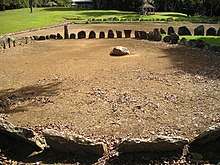
The Taíno played a ceremonial ball game called batey. Opposing teams had 10 to 30 players per team and used a solid rubber ball. Normally, the teams were composed of men, but occasionally women played the game as well.[34] The Classic Taíno played in the village's center plaza or on especially designed rectangular ball courts called batey. Games on the batey are believed to have been used for conflict resolution between communities. The most elaborate ball courts are found at chiefdom boundaries.[32] Often, chiefs made wagers on the possible outcome of a game.[34]
Taíno spoke an Arawakan language and used an early form of writing Proto-writing in the form of petroglyph.[35]
Some words that they used, such as barbacoa ("barbecue"), hamaca ("hammock"), kanoa ("canoe"), tabaco ("tobacco"), yuca, batata ("sweet potato"), and juracán ("hurricane"), have been incorporated into Spanish and English.
For warfare, the men made wooden war clubs, which they called a macana. It was about one inch thick and was similar to the coco macaque.
Cacicazgo/society
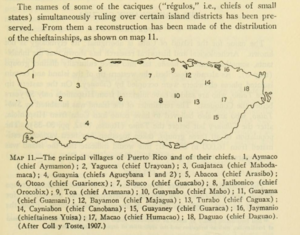
The Taíno were the most culturally advanced of the Arawak Group to settle in what is now Puerto Rico.[36] Individuals and kinship groups that previously had some prestige and rank in the tribe began to occupy the hierarchical position that would give way to the cacicazgo.[37] The Taíno founded settlements around villages and organized their chiefdoms, or cacicazgos, into a confederation.[38] The Taino society, as described by the chroniclers, was composed of four social classes: the cacique, the nitaínos, the behiques, and the naborias.[37] According to archeological evidence, the Taíno islands were able to support an enormous number of people for approximately 1,500 years.[39] Every individual living in the Taíno society had a task to do. For the Taínos, it was very important that everyone living in their islands ate properly.[39] They followed a very efficient nature harvesting and agricultural production system.[39] Either people were hunting, searching for food, or doing other productive tasks.[39]
Tribal groups settled in villages under a chieftain, known as cacique, or cacica if the ruler was a woman. Many women the Spaniards called cacicas were not always rulers in their own right, but were mistakenly recognized as such because they were the wives of caciques. Chiefs were chosen from the nitaínos and generally obtained their power from the maternal line. Male rulers were more likely to be succeeded by his sister's children than his own, unless their mother's lineage allowed them to succeed in their own right.[40]
The chiefs had both temporal and spiritual functions. They were expected to ensure the welfare of the tribe and to protect it from harm from both natural and supernatural forces.[41] They were also expected to direct and manage the production process. The caciques power came from the number of villages he controlled and was based on a network of alliances related to family, matrimonial and ceremonial ties. These alliances showed unity of the indigenous communities in a territory[42] that would get together as a defensive strategy to face external threats, like the attacks by the Caribs on communities in Puerto Rico.[43] Polygamy allowed the cacique to have women in different localities, thus extending his power. The cacique carried, as a symbol of his hierarchy, a guanín of South American origin made of an alloy of gold and copper. This symbolized the first Taíno mythical cacique Anacacuya that means star of the center or central spirit. In addition to the guanín, the cacique used other artifacts and adornments that served to identify it. Some examples are tunics of cotton and feathers, crowns and masks or "guaizas" of cotton with feathers; colored stones, shells or gold;cotton woven belts; and necklaces of snail beads or stones with small masks of gold or other material.[37]
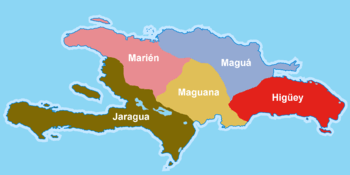
Under the cacique there social organization was composed of two tiers: The nitaínos at the top and the naborias at the bottom.[36] The nitaínos were considered the nobles of the tribes. They were the warriors and family of the cacique.[44] Advisers that assisted in the mundane matters of assigning and supervising communal work, planting and harvesting crops, and keeping peace among the village's inhabitants, were selected from among the nitaínos.[45] The naborias were simply working peasants of the lower class.[44]
The behiques were priests who represented religious beliefs.[44] Behiques dealt with negotiating with angry or indifferent gods as the accepted lords of the spiritual world. The behiques were expected to communicate with the gods, to soothe them when they were angry, and to intercede on the tribe's behalf. It was their duty to cure the sick, heal the wounded, and interpret the will of the gods in ways that would satisfy the expectations of the tribe. Before carrying out these functions, the behiques performed certain cleansing and purifying rituals, such as fasting for several days and inhaling sacred tobacco snuff.[41]
Food and agriculture
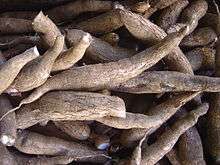
Taíno staples included vegetables, fruit, meat, and fish. There were no large animals native to the Caribbean, but they captured and ate small animals, such as hutias and other mammals, earthworms, lizards, turtles, and birds. Manatees were speared and fish were caught in nets, speared, trapped in weirs, or caught with hook and line. Wild parrots were decoyed with domesticated birds, and iguanas were taken from trees and other vegetation. The Taíno stored live animals until they were ready to be consumed: fish and turtles were stored in weirs, hutias and dogs were stored in corrals.[46]
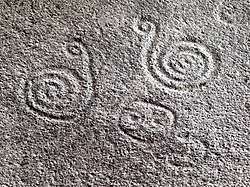
Because of the lack of large game, the Taíno people became very skilled fishermen. One method was to hook a remora, also known as a suckerfish, to a line secured to a canoe and wait for the fish to attach itself to a larger fish or even a sea turtle. Once this happened, some of the Taíno would dive into the water to assist in retrieving the catch. Another method used by the Taínos was to shred the stems and roots of poisonous senna plants and throw them into nearby streams or rivers. Upon eating the bait, the fish were stunned, allowing boys time enough to collect them. This toxin did not affect the edibility of the fish. The Taíno also collected mussels and oysters in shallow waters within the exposed mangrove roots.[47] Some young boys hunted waterfowl from flocks that "darkened the sun", according to Christopher Columbus.[39]
Taíno groups in the more developed islands, such as Puerto Rico, Hispaniola, and Jamaica, relied more on agriculture (farming and other jobs). Fields for important root crops, such as the staple yuca, were prepared by heaping up mounds of soil, called conucos. This improved soil drainage and fertility as well as delaying erosion, allowed for longer storage of crops in the ground. Less important crops such as corn were raised in simple clearings created by slash and burn technique. Typically, conucos were three feet high and nine feet in circumference and were arranged in rows.[48] The primary root crop was yuca or cassava, a woody shrub cultivated for its edible and starchy tuberous root. It was planted using a coa, a kind of hoe made completely from wood. Women processed the poisonous variety of cassava by squeezing it to extract the toxic juices. Then they would grind the roots into flour for baking bread. Batata (sweet potato) was the next most important root crop.[48]
Contrary to mainland practices, corn was not ground into flour and baked into bread, but was cooked and eaten off the cob. Corn bread becomes moldy faster than cassava bread in the high humidity of the Caribbean. Corn also was used to make an alcoholic beverage known as chicha.[49] The Taíno grew squash, beans, peppers, peanuts, and pineapples. Tobacco, calabashes (West Indian pumpkins), and cotton were grown around the houses. Other fruits and vegetables, such as palm nuts, guavas, and Zamia roots, were collected from the wild.[48]
Spirituality
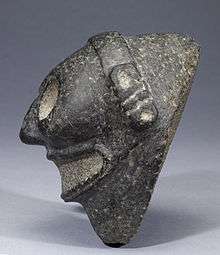
Walters Art Museum
Taíno spirituality centered on the worship of zemís. A zemí is a spirit or ancestor. The major Taíno zemis are Atabey and her son, Yúcahu. Atabey, was the zemi of the moon, fresh waters, and fertility. Other names for her include Atabei, Atabeyra, Atabex, and Guimazoa. The Taínos of Quisqueya (Dominican Republic) called her son, "Yucahú Bagua Maorocotí", which means "White Yuca, great and powerful as the sea and the mountains". He was the spirit of cassava, the zemi of cassava – the Taínos' main crop – and the sea.
Guabancex was the non-nurturing aspect of the zemi Atabey who had control over natural disasters. She is identified as the goddess of the hurricanes or as the zemi of storms. Guabancex had twin sons: Guataubá, a messenger who created hurricane winds, and Coatrisquie, who created floodwaters.[50]
Iguanaboína was the goddess of the good weather. She also had twin sons: Boinayel, the messenger of rain, y Marohu, the spirit of clear skies.[51]
The minor Taíno zemis related to the growing of cassava, the process of life, creation, and death. Baibrama was a minor zemi worshiped for his assistance in growing cassava and curing people from its poisonous juice. Boinayel and his twin brother Márohu were the zemis of rain and fair weather, respectively.[52]
Maquetaurie Guayaba or Maketaori Guayaba was the zemi of Coaybay or Coabey, the land of the dead. Opiyelguabirán', a dog-shaped zemi, watched over the dead. Deminán Caracaracol, a male cultural hero from whom the Taíno believed themselves to be descended, was worshipped as a zemí.[52] Macocael was a cultural hero worshipped as a zemi, who had failed to guard the mountain from which human beings arose. He was punished by being turned into stone, or a bird, a frog, or a reptile, depending on interpretation of the myth.
Lombards Museum
Zemí was also the name the people gave to their physical representations of the Zemis, whether objects or drawings. They were made in many forms and materials and have been found in a variety of settings. The majority of zemís were crafted from wood, but stone, bone, shell, pottery, and cotton were used as well.[53] Zemí petroglyphs were carved on rocks in streams, ball courts, and on stalagmites in caves. Cemí pictographs were found on secular objects such as pottery, and on tattoos. Yucahú, the zemi of cassava, was represented with a three-pointed zemí, which could be found in conucos to increase the yield of cassava. Wood and stone zemís have been found in caves in Hispaniola and Jamaica.[54] Cemís are sometimes represented by toads, turtles, fish, snakes, and various abstract and human-like faces.
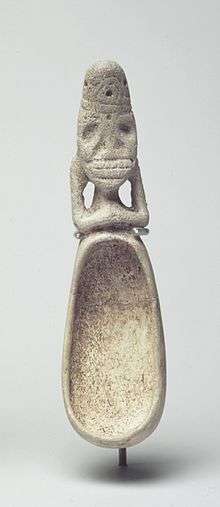
Brooklyn Museum
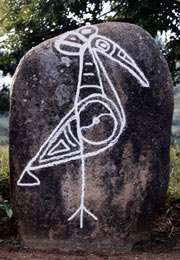
Some zemís are accompanied by a small table or tray, which is believed to be a receptacle for hallucinogenic snuff called cohoba, prepared from the beans of a species of Piptadenia tree. These trays have been found with ornately carved snuff tubes. Before certain ceremonies, Taínos would purify themselves, either by inducing vomiting (with a swallowing stick) or by fasting.[55] After communal bread was served, first to the zemí, then to the cacique, and then to the common people, the people would sing the village epic to the accompaniment of maraca and other instruments.
One Taíno oral tradition explains that the Sun and Moon come out of caves. Another story tells of people who once lived in caves and only came out at night, because it was believed that the Sun would transform them. The Taíno believed they were descended from the union of the cultural hero Deminán Caracaracol and a female turtle. The origin of the oceans is described in the story of a huge flood that occurred when a father murdered his son (who was about to murder the father). The father put his son's bones into a gourd or calabash. When the bones turned into fish, the gourd broke, and all the water of the world came pouring out.
Taínos believed that Jupias, the souls of the dead, would go to Coaybay, the underworld, and there they rest by day. At night they would assume the form of bats and eat the guava fruit.
Spaniards and Taíno
Columbus and the crew of his ship were the first Europeans to encounter the Taíno people, as they landed in The Bahamas on October 12, 1492. After their first interaction, Columbus described the Taínos as a physically tall, well-proportioned people, with a noble and kind personality.
In his diary, Columbus wrote:
They traded with us and gave us everything they had, with good will ... they took great delight in pleasing us ... They are very gentle and without knowledge of what is evil; nor do they murder or steal...Your highness may believe that in all the world there can be no better people ... They love their neighbours as themselves, and they have the sweetest talk in the world, and are gentle and always laughing.[56]
At this time, the neighbors of the Taíno were the Guanahatabeys in the western tip of Cuba, the Island-Caribs in the Lesser Antilles from Guadeloupe to Grenada, and the Calusa and Ais nations of Florida. Guanahaní was the Taíno name for the island that Columbus renamed as San Salvador (Spanish for "Holy Savior"). Columbus called the Taíno "Indians", a reference that has grown to encompass all the indigenous peoples of the Western Hemisphere. A group of Taíno people accompanied Columbus on his return voyage to Spain.[57]
On Columbus' second voyage to their culture, he began to require tribute from the Taíno in Hispaniola. According to Kirkpatrick Sale, each adult over 14 years of age was expected to deliver a hawks bell full of gold every three months, or when this was lacking, twenty-five pounds of spun cotton. If this tribute was not brought, the Spanish cut off the hands of the Taíno and left them to bleed to death.[58] These cruel practices inspired many revolts by the Taíno and campaigns against the Spanish — some being successful, some not.
In 1511, several caciques in Puerto Rico, such as Agüeybaná II, Arasibo, Hayuya, Jumacao, Urayoán, Guarionex, and Orocobix, allied with the Carib and tried to oust the Spaniards. The revolt was suppressed by the Indio-Spanish forces of Governor Juan Ponce de León.[59] Hatuey, a Taíno chieftain who had fled from Hispaniola to Cuba with 400 natives to unite the Cuban natives, was burned at the stake on February 2, 1512.
In Hispaniola, a Taíno chieftain named Enriquillo mobilized more than 3,000 Taíno in a successful rebellion in the 1520s. These Taíno were accorded land and a charter from the royal administration. Despite the small Spanish military presence in the region, they often used diplomatic divisions and, with help from powerful native allies, controlled most of the region.[60][61] In exchange for a seasonal salary, religious and language education, the Taíno were required to work for Spanish and Indian land owners. This system of labor was part of the encomienda.
Women
Taíno society was based on a matrilineal system and descent was traced through the mother. Women lived in village groups containing their children. The men lived separately. Because of this Taíno women had extensive control over their lives, their co-villagers, and their bodies.[62] Since they lived separately from men, they were able to decide when they wanted to participate in sexual contact. This social organization partially shaped the views of conquistadors who came in contact with Taíno culture. They reportedly perceived women as "macha women" who had strong control over the men.
Taíno women played an important role in intercultural interaction between Spaniards and the Taíno people. When Taíno men were away fighting intervention from other groups, women assumed the roles of primary food producers or ritual specialists.[63] Women seem to have participated in all levels of the Taíno political hierarchy, occupying roles as high up as being cazicas.[64] Potentially, this meant Taíno women could make important choices for the village and could assign tasks to tribe members.[65] There is evidence that suggests that the women who were wealthiest among the tribe collected crafted goods that they would then use for trade or as gifts.
Despite women being seemingly independent in Taíno society, during the era of contact Spaniards took Taíno women as an exchange item, putting them in a non-autonomous position. Dr. Chanca, a physician who traveled with Christopher Columbus, reported in a letter that Spaniards took as many women as they possibly could and kept them as concubines.[66] Some sources report that, despite women being free and powerful before the contact era, they became the first commodities up for Spaniards to trade, or often, steal. This marked the beginning of a lifetime of kidnapping and abuse of Taíno women.[67]
Depopulation
Early population estimates of Hispaniola, probably the most populous island inhabited by Taínos, range from 100,000 to 1,000,000 people. The maximum estimates for Jamaica and Puerto Rico are 600,000 people.[24] The Spanish priest and defender of the Taíno Bartolomé de las Casas (who had lived in Santo Domingo) wrote in his 1561 multi-volume History of the Indies:[68]
There were 60,000 people living on this island [when I arrived in 1508], including the Indians; so that from 1494 to 1508, over three million people had perished from war, slavery and the mines. Who in future generations will believe this?
Researchers today doubt Las Casas' figures for the pre-contact levels of the Taíno population, considering them an exaggeration. For example, Anderson Córdova estimates a maximum of 500,000 people inhabiting the island.[69] They had no resistance to Old World diseases, notably smallpox.[70] The encomienda system brought many Taíno to work in the fields and mines in exchange for Spanish protection,[71] education, and a seasonal salary.[72] Under the pretense of searching for gold and other materials,[73] many Spaniards took advantage of the regions now under control of the anaborios and Spanish encomenderos to exploit the native population by seizing their land and wealth. Historian David Stannard characterizes the encomienda as a genocidal system which "had driven many millions of native peoples in Central and South America to early and agonizing deaths."[74] It would take some time before the Taíno revolted against their oppressors — both Indian and Spanish alike — and many military campaigns before Emperor Charles V eradicated the encomienda system as a form of slavery.[75][76]
Diseases obviously had a lot to do with the decimation of the indigenous population, but forced labor was also one of the chief reasons as to why the population decimated. The first man to introduce this forced labor among the Taínos was leader of the European colonization of Puerto Rico, Ponce de León. This forced labor eventually led to the Taíno rebellions, in which the Spaniards responded with violent military expeditions known as cabalgadas. The purpose of the military expedition was to capture the indigenous peoples. This violence by the Spaniards was a reason why there was a decline in the Taíno population since it forced many of these people to emigrate.
In thirty years, between 80% and 90% of the Taíno population died.[77] Because of the increased number of people (Spanish) on the island, there was a higher demand for food. Taíno cultivation was converted to Spanish methods. In hopes of frustrating the Spanish, some Taínos refused to plant or harvest their crops. The supply of food became so low in 1495 and 1496 that some 50,000 died from famine.[78] Historians have determined that the massive decline was due more to infectious disease outbreaks than any warfare or direct attacks.[79][80] By 1507, their numbers had shrunk to 60,000. Scholars believe that epidemic disease (smallpox, influenza, measles, and typhus) was an overwhelming cause of the population decline of the indigenous people,[81] and also attributed a "large number of Taíno deaths...to the continuing bondage systems" that existed.[82][83] Academics, such as historian Andrés Reséndez of the University of California, Davis, assert that disease alone does not explain the total destruction of indigenous populations of Hispaniola. While the populations of Europe rebounded following the devastating population decline associated with the Black Death, there was no such rebound for the indigenous populations of the Caribbean. He concludes that, even though the Spanish were aware of deadly diseases such as smallpox, there is no mention of them in the New World until 1519, meaning perhaps they didn't spread as fast as initially believed, and that unlike Europeans, the indigenous populations were subjected to slavery, exploitation, and forced labor in gold and silver mines on an enormous scale.[84] Reséndez says that "slavery has emerged as a major killer" of the indigenous people of the Caribbean.[16] Anthropologist Jason Hickel of the London School of Economics estimates that a third of indigenous workers died every six months from lethal forced labor in these mines.[85]
Taíno descendants today
Histories of the Caribbean commonly describe the Taino as extinct, killed off by disease, slavery, and war with the Spaniards. Some present-day residents of the Caribbean self-identify as Taino, and claim that Taino culture and identity have survived into the present.[86] Groups advocating this point of view are known as Neo-Taínos, and are established in the Puerto Rican communities located in New Jersey and New York, as well. A few Neo-Taíno groups are pushing not only for recognition, but respect for their cultural assets.[87]
A genetic study published in 2018 provided some evidence of a present-day Caribbean population being related to the Taínos. DNA was extracted from a tooth of a 1,000-year-old female skeleton found in a cave in Lucaya, Bahamas, and the genetic results show that she is most closely related to present-day Arawakan speakers from northern South America. The study's authors write that this demonstrates continuity between pre-contact populations and present-day Latino populations in the Caribbean.[88][89] Today, Taínos from places such as the diaspora in the United States and the islands, are gathering together.[90]
As of 2006, there were a couple of dozen activist Taino organizations from Florida to Puerto Rico and California to New York with growing memberships numbering in the thousands. These efforts are known as the "Taíno restoration", a revival movement for Taíno culture that seeks official recognition of the survival of the Taíno people.[91]
In Puerto Rico, the history of the Taíno is being taught in schools and children are encouraged to celebrate the culture and identity of Taíno through dance, costumes and crafts. Martínez Cruzado, a geneticist at the University of Puerto Rico at Mayagüez said celebrating and learning about their Taíno roots is helping Puerto Ricans feel connected to one another.[92]
While the scholar Yolanda Martínez-San Miguel sees the development of the Neo-Taino movement in Puerto Rico as a useful counter to the domination of the island by the United States and the Spanish legacies of island society, she also notes that the Neo-Taino movement in Puerto Rico "could be seen as a useless anachronistic reinvention of a 'Boricua coqui' identity.[93]
See also
- Ciboney
- Enriquillo, rebel cacique
- Garifuna
- Hupia, spirit of the dead
- Indigenous Amerindian genetics
- Island Caribs
- Juracán, god of chaos
- List of Taínos
- Pomier Caves
- Tibes Indigenous Ceremonial Center
- West Indies
- Yúcahu, central Taíno deity
- Yamaye
Notes
- Eli D. Oquendo-Rodríguez. Pablo L. Crespo-Vargas, editor. A Orillas del Mar Caribe: Boceto histórico de la Playa de Ponce - Desde sus primeros habitantes hasta principios del siglo XX. First edition. June, 2017. Editorial Akelarre. Centro de Estudios e Investigaciones del Sur Oeste de Puerto Rico (CEISCO). Lajas, Puerto Rico. Page 15. ISBN 978-1547284931
- Rouse 1992, p. 161.
- "Taino". Encyclopædia Britannica. 2018.
- Poole, Robert M. (October 2011). "What Became of the Taíno". Smithsonian Magazine. Archived from the original on November 5, 2018. Retrieved November 3, 2018.
- Sherina Feliciano-Santos. 2011. An Inconceivable Indigeneity: The Historical, Cultural, and Interactional Dimensions of Puerto Rican Activism. University of Michigan, doctoral dissertation. Archived 2012-04-24 at the Wayback Machine
- "The Taíno were written off as extinct. Until now". Newsweek.com. 20 February 2018. Archived from the original on 2018-05-08. Retrieved 19 May 2018.
- "What Became of the Taíno?".
- Guitar 2000.
- Baracutei Estevez, Jorge (14 October 2019). "Meet the survivors of a 'paper genocide'". National Geographic. Archived from the original on 17 October 2019. Retrieved 8 November 2019.
- Agorsah, E. Kofi, "Archaeology of Maroon Settlements in Jamaica", Maroon Heritage: Archaeological, Ethnographic and Historical Perspectives, ed. E. Kofi Agorsah (Kingston: University of the West Indies Canoe Press, 1994), pp. 180–1.
- Haslip-Viera, Gabriel (2014). Race, Identity and Indigenous Politics: Puerto Rican Neo-Taínos in the Diaspora and the Island. Latino Studies Press. pp. 111–117.
- Vilar, Miguel G.; et al. (July 2014). "Genetic diversity in Puerto Rico and its implications for the peopling of the island and the Caribbean". American Journal of Physical Anthropology. 155 (3): 352–68. doi:10.1002/ajpa.22569. PMID 25043798.
- Moure, Ramon Dacal; Calle, Manuel Rivero De La (15 February 1997). Art and Archaeology of Pre-Columbian Cuba. University of Pittsburgh Pre. ISBN 9780822990703. Archived from the original on 30 December 2016. Retrieved 19 May 2018 – via Google Books.
- "What Became of the Taíno?". Smithsonian. Archived from the original on 2019-10-14. Retrieved 2019-10-10.
- Chrisp 2006, p. 34.
- Reséndez, Andrés (2016). The Other Slavery: The Uncovered Story of Indian Enslavement in America. Houghton Mifflin Harcourt. p. 17. ISBN 978-0547640983. Archived from the original on 2019-10-14. Retrieved 2019-06-21.
- Abbot 2010.
- Alfred W. Crosby, The Columbian Exchange Westport, 1972, p. 47.
- Alexandra Aikhenvald (2012) Languages of the Amazon, Oxford University Press
- "American Indian and Alaska Native Tribes in the United States and Puerto Rico: 2010 (CPH-T-6)". Census.gov. Census bureau. 2010. Archived from the original on October 4, 2015. Retrieved September 14, 2016.
- Barreiro, José (1998). Rethinking Columbus – The Taínos: "Men of the Good". Milwaukee, Wisconsin: Rethinking Schools, Ltd. pp. 106. ISBN 978-0-942961-20-1.
- Alegría, "Taínos" vol. 1, p. 345.
- Daniel Garrison Brinton (1871). "The Arawack language of Guiana in its linguistic and ethnological relations". Philadelphia, McCalla & Stavely. Archived from the original on 28 May 2016. Retrieved 22 June 2016.
- Rouse 1992, p. 7.
- Rouse, pp. 30–48.
- Martínez-Cruzado, JC; Toro-Labrador, G; Ho-Fung, V; et al. (Aug 2001). "Mitochondrial DNA analysis reveals substantial Native American ancestry in Puerto Rico". Hum. Biol. 73 (4): 491–511. doi:10.1353/hub.2001.0056. PMID 11512677.
- Lorena Madrigal, Madrigal (2006). Human biology of Afro-Caribbean populations. Cambridge University Press, 2006. p. 121. ISBN 978-0-521-81931-2.
- Rouse, p. 16.
- Young, Susan (October 17, 2011). "Rebuilding the genome of a hidden ethnicity". Nature. doi:10.1038/news.2011.592. Archived from the original on 2018-09-01. Retrieved 2019-01-08.
- "Caciques, nobles and their regalia". elmuseo.org. Archived from the original on 2006-10-09. Retrieved 2006-11-09.
- Beding, Silvio, ed. (1002). The Christopher Columbus Encyclopedia (ebook ed.). Palgrave MacMillan. p. 346. ISBN 978-1-349-12573-9. Archived from the original on 2017-04-12. Retrieved 11 April 2017.
- Rouse, p. 15.
- Alegría, "Tainos" p. 346.
- Alegría (1951), p.348.
- "Taino Symbol Meanings". Tainoage.com. Archived from the original on 2018-07-05. Retrieved 19 May 2018.
- Jimenez de Wagenheim, Olga (1998). Puerto Rico: an interpretive history from pre-columbian times to 1900. Markus Wiener Publishers. p. 12. ISBN 1558761225. OCLC 1025952187.
- "El desarrollo del cacicazgo en las sociedades tardías de Puerto Rico -". enciclopediapr.org. Archived from the original on 2019-05-27. Retrieved 2019-05-10.
- Wagenheim, Olga Jiménez de (1998). Puerto Rico : an interpretive history from pre-Columbian times to 1900. Princeton, N.J.: Markus Wiener Publishers. p. 12. ISBN 1558761217. OCLC 37457914.
- Bigelow, Bill; Peterson, Bob (1998). Rethinking Columbus: The Next 500 Years. Rethinking Schools. ISBN 9780942961201.
- Jimenez de Wagenheim, Olga (1998). Puerto Rico: an interpretive history from pre-columbian times to 1900. Markus Wiener Publishers. pp. 12–13. ISBN 1558761225. OCLC 1025952187.
- Jimenez de Wagenheim, Olga (1998). Puerto Rico: an interpretive history from pre-columbian times to 1900. Markus Wiener Publishers. p. 13. ISBN 1558761225. OCLC 1025952187.
- "Bulletin : Smithsonian Institution. Bureau of American Ethnology". Internet Archive. 23 October 1901. Archived from the original on 18 May 2016. Retrieved 7 November 2019.
- Rodríguez Ramos, Reniel (2019-02-25), "Current Perspectives in the Precolonial Archaeology of Puerto Rico", Oxford Research Encyclopedia of Latin American History, Oxford University Press, doi:10.1093/acrefore/9780199366439.013.620, ISBN 9780199366439
- "Indios Tainos". www.proyectosalonhogar.com. Archived from the original on 2016-01-14. Retrieved 2019-05-10.
- Jimenez de Wagenheim, Olga (1998). Puerto Rico: an interpretive history from pre-columbian times to 1900. Markus Wiener Publishers. ISBN 1558761225. OCLC 1025952187.
- Rouse, p. 13.
- Francine Jacobs (1992). The Tainos: The People who Welcomed Columbus. G.P. Putnam's Sons. p. 26. ISBN 978-0-399-22116-3.
- Rouse, p.12.
- Duke, Guy S. "Continuity, Cultural Dynamics, and Alcohol: The Reinterpretation of Identity through Chicha in the Andes". Identity Crisis: Archaeological Perspectives on Social Identity. Academia.edu. Archived from the original on 2018-12-10. Retrieved 2017-12-03.
- Rouse, p. 121.
- Robiu-Lamarche, Sebastián (2006). Mitología y religión de los taínos. San Juan, Puerto Rico: Edit. Punto y Coma. pp. 69, 84. ISBN 0-9746236-4-4.
- Rouse, p. 119.
- Rouse, pp. 13, 118.
- Rouse, p. 118.
- Rouse, p. 14.
- Kirkpatrick Sale, The Conquest of Paradise, p. 100, ISBN 0-333-57479-6
- Allen, John Logan (1997). North American Exploration: A New World Disclosed. Volume: 1. University of Nebraska Press. p. 13.
- Kirkpatrick Sale, "The Conquest of Paradise", p. 155, ISBN 0-333-57479-6
- Anghiera Pietro Martire D' (July 2009). De Orbe Novo, the Eight Decades of Peter Martyr D'Anghera. p. 143. ISBN 9781113147608. Retrieved 31 July 2010.
- Anghiera Pietro Martire D' (July 2009). De Orbe Novo, the Eight Decades of Peter Martyr D'Anghera. p. 132. ISBN 9781113147608. Retrieved 10 July 2010.
- Anghiera Pietro Martire D' (July 2009). De Orbe Novo, the Eight Decades of Peter Martyr D'Anghera. p. 199. ISBN 9781113147608. Retrieved 10 July 2010.
- Saunders, Nicholas J. Peoples of the Caribbean: An Encyclopedia of Archeology and Traditional Culture. Santa Barbara, CA: ABC-CLIO, 2005. Web.
- Dale, Corrine H., and J. H. E. Paine. Women on the Edge: Ethnicity and Gender in Short Stories by American Women. New York: Garland Pub., 1999. Web.
- Taylor, Patrick, and Frederick I. Case. The Encyclopedia of Caribbean Religions Volume 1: A-L; Volume 2: M-Z. Baltimore: U of Illinois, 2015. Web. Chapter title Taínos.
- Deagan, Kathleen (2004). "Reconsidering Taino Social Dynamics after Spanish Conquest: Gender and Class in Culture Contact Studies". American Antiquity. 69 (4): 597–626. doi:10.2307/4128440. JSTOR 4128440.
- Hotep, Amon. "Women." Race and History.com | TAINO | Women. N.p., n.d. Web. 29 Nov. 2016.
- Sloan, Kathryn A. Women's Roles in Latin America and the Caribbean. Santa Barbara, CA: Greenwood, 2011. Web.
- "Endless War of Domination". Student-Employee Assistance Program Against Chemical Dependency. Archived from the original on 2007-10-16. Retrieved 2007-10-02.
- Karen Anderson Córdova (1990). Hispaniola and Puerto Rico: Indian Acculturation and Heterogeneity, 1492–1550 (PhD dissertation). Ann Arbor, Michigan: University Microfilms International.
- Citation Needed
- Anghiera Pietro Martire D' (July 2009). De Orbe Novo, the Eight Decades of Peter Martyr D'Anghera. p. 112. ISBN 9781113147608. Retrieved 21 July 2010.
- Anghiera Pietro Martire D' (July 2009). De Orbe Novo, the Eight Decades of Peter Martyr D'Anghera. p. 182. ISBN 9781113147608. Retrieved 21 July 2010.
- Anghiera Pietro Martire D' (July 2009). De Orbe Novo, the Eight Decades of Peter Martyr D'Anghera. p. 111. ISBN 9781113147608. Retrieved 21 July 2010.
- Stannard, David E. (1993). American Holocaust: The Conquest of the New World. Oxford University Press. p. 139. ISBN 978-0195085570.
- Anghiera Pietro Martire D' (July 2009). De Orbe Novo, the Eight Decades of Peter Martyr D'Anghera. p. 143. ISBN 9781113147608. Retrieved 21 July 2010.
- David M. Traboulay (1994). Columbus and Las Casas: the conquest and Christianization of America, 1492–1566. p. 44. ISBN 9780819196422. Retrieved 21 July 2010.
- "La tragédie des Taïnos", in L'Histoire n°322, July–August 2007, p. 16.
- Anghiera Pietro Martire D' (July 2009). De Orbe Novo, the Eight Decades of Peter Martyr D'Anghera. p. 108. ISBN 9781113147608. Retrieved 21 July 2010.
- Anghiera Pietro Martire D' (July 2009). De Orbe Novo, the Eight Decades of Peter Martyr D'Anghera. p. 160. ISBN 9781113147608. Retrieved 21 July 2010.
- Arthur C. Aufderheide; Conrado Rodríguez-Martín; Odin Langsjoen (1998). The Cambridge encyclopedia of human paleopathology. Cambridge University Press. pp. 204. ISBN 978-0-521-55203-5. Archived from the original on 2016-02-02. Retrieved 2016-01-05.
- Watts, Sheldon (2003). Disease and medicine in world history. Routledge. pp. 86, 91. ISBN 978-0-415-27816-4. Archived from the original on 2016-02-02. Retrieved 2016-01-05.
- Schimmer, Russell. "Puerto Rico". Genocide Studies Program. Yale University. Archived from the original on 2011-09-08. Retrieved 2011-12-04.
- Raudzens, George (2003). Technology, Disease, and Colonial Conquests, Sixteenth to Eighteenth Centuries. Brill. p. 41. ISBN 978-0-391-04206-3. Archived from the original on 2016-02-02. Retrieved 2016-01-05.
- Treuer, David (May 13, 2016). "The new book 'The Other Slavery' will make you rethink American history". The Los Angeles Times. Archived from the original on June 23, 2019. Retrieved June 22, 2019.
- Hickel, Jason (2018). The Divide: A Brief Guide to Global Inequality and its Solutions. Windmill Books. p. 70. ISBN 978-1786090034.
- Poole, Robert M. (October 2011). "What Became of the Taíno?". Smithsonian. Retrieved 13 December 2019.
- Curet, Antonio L. (Spring 2015). "Indigenous Revival, Indigeneity, and the Jíbaro in Borikén". Centro Journal. 27: 206–247.
- Schroeder, Hannes; Sikora, Martin; Gopalakrishnan, Shyam; Cassidy, Lara M.; Delser, Pierpaolo Maisano; Velasco, Marcela Sandoval; Schraiber, Joshua G.; Rasmussen, Simon; Homburger, Julian R.; Ávila-Arcos, María C.; Allentoft, Morten E.; Moreno-Mayar, J. Víctor; Renaud, Gabriel; Gómez-Carballa, Alberto; Laffoon, Jason E.; Hopkins, Rachel J. A.; Higham, Thomas F. G.; Carr, Robert S.; Schaffer, William C.; Day, Jane S.; Hoogland, Menno; Salas, Antonio; Bustamante, Carlos D.; Nielsen, Rasmus; Bradley, Daniel G.; Hofman, Corinne L.; Willerslev, Eske (March 6, 2018). "Origins and genetic legacies of the Caribbean Taino". Proceedings of the National Academy of Sciences. 115 (10): 2341–2346. doi:10.1073/pnas.1716839115. PMC 5877975. PMID 29463742.
- "Genes of 'extinct' Caribbean islanders found in living people". Science | AAAS. February 19, 2018.
- Estevez, Jorge Baracutei (August 30, 2017). "CARIBBEAN TAINO AND GUYANA INDIGENOUS PEOPLES CACIQUE CROWN A SYMBOL OF BROTHERHOOD - CELEBRATING OUR INDIGENOUS HERITAGE THE ART OF FEATHER WORK CACHUCHABANA FEATHER HEADDRESSES OF THE TAINO PEOPLES" (PDF). Guyana Folk & Culture. US: Guyana Cultural Association of New York Inc.on-line Magazine. pp. 6–7. Retrieved December 12, 2019.
- L. Guitar; P. Ferbel-Azcarate; J. Esteves (2006). "Ocama-Daca Taíno". In Maximilian Christian Forte (ed.). Indigenous Resurgence in the Contemporary Caribbean: Amerindian Survival and Revival. Peter Lang. p. 62. ISBN 978-0-8204-7488-5.
- Cave, Damien (December 2, 2008). "Puerto Rico pageant celebrates a vanished native culture". The New York Times.
- Martínez-San Miguel, Yolanda (Spring 2011). "Taino Warriors?: Strategies for Recovering Indigenous Voices in Colonial and Contemporary Hispanic Caribbean Discourses" (PDF). Centro Journal. 13: 211.
References
- Abbot, Elizabeth (1 April 2010). Sugar: A Bitterweet History. Penguin. ISBN 978-1-59020-772-7. Retrieved 5 March 2013.CS1 maint: ref=harv (link)
- Chrisp, P. (2006). DK Discoveries: Christopher Columbus. Penguin. ISBN 978-0-7566-8616-1. Retrieved 5 March 2013.
- Ricardo Alegría (April 1951). "The Ball Game Played by the Aborigines of the Antilles". American Antiquity. 16 (4): 348–352. doi:10.2307/276984. JSTOR 276984.
- Rouse, Irving (1992). The Tainos: Rise and Decline of the People Who Greeted Columbus. Yale University Press. ISBN 0-300-05696-6.CS1 maint: ref=harv (link)
Further reading
- Accilien, Cécile; Adams, Jessica; Méléance, Elmide (2006). Revolutionary Freedoms: A History of Survival, Strength and Imagination in Haiti. Paintings by Ulrick Jean-Pierre. Educa Vision Inc. ISBN 978-1-58432-293-1. Retrieved 21 February 2013.
- Léger, Jacques Nicolas (1907). Haiti, Her History and Her Detractors. Neale Publishing Company. Retrieved 21 February 2013.CS1 maint: ref=harv (link) wikisource
- Guitar L (2000). "Criollos: The Birth of a Dynamic New Indo-Afro-European People and Culture on Hispaniola". Kacike. Caribbean Amerindian Centrelink. 1 (1): 1–17. ISSN 1562-5028.CS1 maint: ref=harv (link)
- Guitar, Lynne; Ferbel-Azcarate, Pedro; Estevez, Jorge (2006). "Ocama-Daca Taíno (Hear Me, I Am Taíno): Taíno Survival on Hispaniola, Focusing on the Dominican Republic". In Forte, Maximilian C. (ed.). Indigenous Resurgence in the Contemporary Caribbean: Amerindian Survival and Revival. New York: Peter Lang Publishing. ISBN 978-0820474885.CS1 maint: ref=harv (link)
- DeRLAS. "Some important research contributions of Genetics to the study of Population History and Anthropology in Puerto Rico". Newark, Delaware: Delaware Review of Latin American Studies. August 15, 2000.
- "The Role of Cohoba in Taíno Shamanism", Constantino M. Torres in Eleusis No. 1 (1998)
- "Shamanic Inebriants in South American Archaeology: Recent Investigations" Constantino M. Torres in Eleusis No. 5 (2001)
- Tinker, T & Freeland, M. 2008. "Thief, Slave Trader, Murderer: Christopher Columbus and Caribbean Population Decline". Wicazo Sa Review, Vol. 23, No. 1, Spring, 2008: 25–50. Retrieved from Academic Search Premier Database on 23 Sept. 2008.
- Guitar, Lynne. "Documenting the Myth of Taíno Extinction". Kacike.
- The art heritage of Puerto Rico, pre-Columbian to present. New York: The Metropolitan Museum of Art and El Museo del Barrio. 1973. (Chapter 1: "The Art of the Taino Indians of Puerto Rico")
External links
| Wikimedia Commons has media related to Taíno. |
- Statehood Issue Stirs Passions About Puerto Rican Identity.
- Island Thresholds, Peabody Essex Museum's interactive feature, showcases the work of Caribbean artists and their exploration of culture and identity.
- The Cave of Wonders - Taino Cave Art in La Romana
- Taíno Diccionary, A dictionary of words of the indigenous peoples of caribbean from the encyclopedia "Clásicos de Puerto Rico, second edition, publisher, Ediciones Latinoamericanas. S.A., 1972" compiled by Puerto Rican historian Dr. Cayetano Coll y Toste of the "Real Academia de la Historia".
- 2011 Smithsonian article on Taíno culture remnant in the Dominican Republic